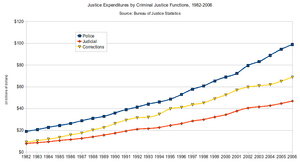by Tabetha Cooper
Through observation it has been noticed that many people confuse criminology with criminal justice, thinking at times that they are the same thing. This paper is going to define what each are, explain how they are different, and show you the relationship between both. To begin with, it has been cited by Kathryn Sellers from source unknown to me that “Criminology is to criminal justice as theory is to policy.”
Criminology is “the scientific study of the nature, extent, cause, and control of criminal
 |
| Cover of Criminology: The Core |
behavior” (Criminology: The Core, 2008. pg. 2). On the other hand criminal justice is “thecriminal (penal) law, the law ofcriminal procedure, and thearray of procedures andactivities having to do with theenforcement of this body of law” (Criminal Justice Today, 2007. pg. 14). A simpler definition would be that criminal justice is the agencies that deal with offenders such as police departments, courts, and correctional facilities.
As can be told by the definitions, criminology and criminal justice are two very different things. Criminology is the study and theories of crime. It focuses on what causes crime and what things presumably can be done to lower the crime rates. Criminal justice is the creation and enforcement of the laws. Laws are governed by the Federal courts and upheld by law enforcement agencies. The local courts deal with the prosecution and sentencing of offenders and the correctional facilities house the criminals and enforce their punishment.
After the criminologist have studied the causation of crime and have developed theories on how to lower the recidivism rates, they sometimes petition the courts for laws to be imposed that support their theories. Over the course of time different theories have played a part in the creation of laws. One of the most influential theories is the rational choice theory that states that an offender evaluates their actions prior to ever committing an offense. As said by Siegel 2008, a part of this theory is making the punishment harsher for offender, therefore minimizing their gains when compared to the risks.
 |
| English: This is a chart illustrating the amount spent on criminal justice by function from 1982-2006, from the Bureau of Justice Statistics. (Photo credit: Wikipedia) |
According to http://www.popcenter.org/about/?p=situational, a theory that that is being considered today is the opportunity theory. This theory states that crime can only happen if there is an opportunity to commit such an act. The opportunity theory can help law enforcement officers to literate the importance of minimizing the chances of victimization through eliminating the opportunity for a criminal to take advantage of a situation. Officers can inform the public and local business of the different measurements that can be taken to protect themselves from becoming victims of a senseless crime. Inferences can be made that this theory is what has made many cities decide to install video surveillance camera in public places, helping to deter criminal acts.
Now that the definitions have been given and the difference has been established, one could see how criminology and criminal justice are two separate things that work hand in hand to keep crime at a minimum. In short, criminology is the theory of crime and criminal justice is the policy that enforces it. As the field of criminology grows, a safe assumption would be that the criminal justice system will see a decrease in the offenders running through it.
References
http://www.popcenter.org/about/?p=situationalRetrieved 1.25.10
Schmalleger, F. (2007). Criminal Justice Today: An Introductory Text for the 21st Century (9th
ed.). Upper Saddle River, NJ: Prentice Hall. Retrieved 1.24.10
Sellers, Kathryn (2010). CJ 102-02. Kaplan University Retrieved 1.23.10
Siegel, L. J. (2008). Criminology: The Core (3rd ed.). Belmont, Ca. Cengage Learning.
Retrieved 1.23.10

















0 comments:
Post a Comment